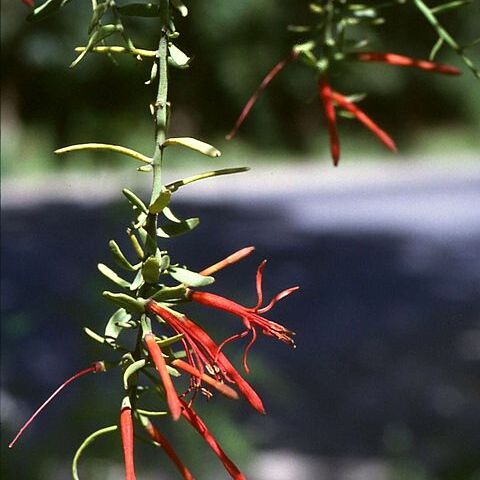Hemiparasitic shrubs on branches of woody plants, attached by woody haustoria with or without epicortical runners producing secondary haustoria; rarely terrestrial root-parasitic shrubs or trees. Leaves mostly opposite, rarely verticillate, displaced-opposite or alternate, exstipulate; lamina entire, curvinerved or penninerved. Inflorescence terminal or lateral; flowers bisexual, rarely unisexual, borne singly or in pairs or 3-flowered dichasia (triads) or tetrads on the inflorescence axis; bract usually 1 per flower. Calyx reduced to an entire, lobed or toothed limb. Petals free or united, usually 4-6, valvate. Stamens as many as petals, epipetalous; anthers 2-or 4-locular (sometimes with transverse partitions), usually basifixed, immobile and introrse, but sometimes dorsifixed and then usually versatile, opening longitudinally. Ovary inferior, with 1-4 obscure locules and lacking differentiated ovules; sporogenous tissue in a lobed placental column or a central mass. Style and stigma simple. Fruit usually baccate, rarely drupaceous (dry and winged in Nuytsia ); seed 1, usually surrounded by a viscous layer developed from layer of fruit wall outside vascular bundles leading to corolla.
Flowers bisexual (rarely unisexual elsewhere), variously borne singly or in racemes, umbels or heads (elsewhere often in 3-flowered dichasia) in axils, at old nodes or terminally, in Africa often large and brightly coloured; bracts usually 1 per flower, cupular or unilateral, with a small to leafy limb
Stamens the same number as the perianth-segments and inserted on them or at their base; anthers 2-celled or rarely 1-celled, sometimes divided into numerous small cells, opening lengthwise or by pores or transverse slits
Shrubs hemiparasitic on the branches (or elsewhere rarely the roots) of other dicotyledons, attached by woody haustoria, with or without surface runners producing secondary haustoria, generally evergreen
Stamens as many as petals, epipetalous; anther basifixed in Africa, 2–4-thecous, sometimes locellate, opening lengthwise
Ovary (receptacle) inferior, with 1–several obscure locules and lacking differentiated ovules; style and stigma simple
Seeds without a testa, normally surrounded by a sticky layer developed from fruit-wall outside the vascular bundles
Ovary inferior, usually without a distinct placenta and ovule; style simple or absent, stigma more or less capitate
Leaves mostly opposite or whorled, simple, entire, sometimes reduced to scales, rarely alternate; stipules absent
Petals free or united, 4–5 in Africa, valvate, radially symmetrical or tube opening with a unilateral split
Leaves opposite, alternate or whorled, simple, entire, often leathery or rather fleshy, estipulate
Perianth-segments valvate, free or united high up into a tube which is often split down one side
Seed solitary, without a distinct testa; endosperm present or absent; embryo large
Rudimentary ovary sometimes (not in Africa) present in male, staminodes in female
Flowers mostly actinomorphic, bisexual or unisexual, often brightly coloured
Parasitic shrubs on trees, or rarely erect terrestrial trees or shrubs
Fruit a berry in Africa (rarely dry and winged elsewhere)
Receptacle sometimes with a calyx-like rim (calyculus)
Calyx rim-like to tubular, entire to shortly toothed
Fruit a berry or drupe
Disk present or absent

